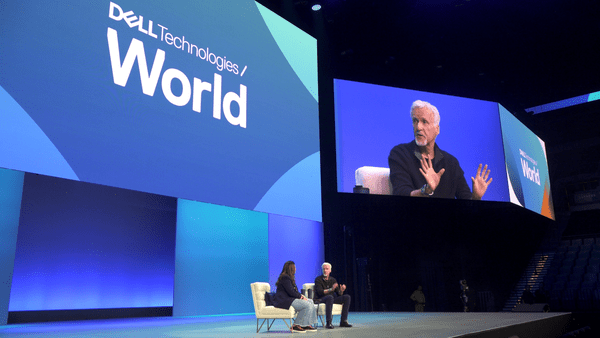
Innovation can make the impossible possible, bringing new visions to life and inspiring generations to dream big. No one knows that better than James Cameron, the film-industry pioneer behind the blockbuster “Alien,” “Terminator” and “Avatar” franchises. From his humble beginnings as an aspiring screenwriter who worked as a truck driver to support his passion, today Cameron is a widely-respected director and master of turning ideas into reality.
At Dell Technologies World 2023, Cameron sat down with Dell’s Chief Marketing Officer, Allison Dew, for a conversation about “catalysts of innovation.” During the session, he revealed where he finds the spark for his creative processes, how he keeps teams engaged for long-term projects like “Avatar” and how he approaches technology in filmmaking. The discussion shed light on how one visionary leader has made innovation central to both his job and his life. Here’s a look at a few of the top takeaways for those ready to be catalysts of innovation themselves.
“I think you win in the long run by being ahead of the curve and anticipating where we need to go.” – James Cameron, Academy Award-winning filmmaker
Lead by example
In 2012, Cameron, who is also a highly accomplished explorer, successfully piloted the Deepsea Challenger submersible 36,000 feet underwater to the deepest-known point in the ocean. Years later, for “Avatar: The Way of Water,” A-list actors like Kate Winslet and Sigourney Weaver trained to hold their breath for more than six minutes so they could remain submerged for filming, and even the set’s underwater camera operators filmed without scuba gear.
Cameron made it clear that he lives the way he expects his team to operate, fearlessly pushing into the unknown. “It’s all about that desire to go beyond yourself and your own prior limitations,” he said.
Similarly, Cameron added, whenever it seems like a filmmaking project could go on forever with all the work to be done, he likes to tell himself, “Quit your whining; you’re getting to do the coolest thing in the world.” With that in mind, he said, he’s usually able to lead by example and convince his team that any challenge they’re facing can be overcome.
See every challenge as an opportunity

After Cameron wrote the script for “Avatar” in 1995 and then realized the technology he needed for the film hadn’t been created yet, he took the script and stuck it in a drawer, knowing he’d return to it eventually. When he did so 10 years later, computer-generated imagery (CGI) had come a long way, but not to the point where characters could be rendered at the photorealistic level he required. Cameron could have given up and shelved the project again, but he opted instead to move forward full-throttle, working with his team to integrate a technique called “performance-capture” that conveys realistic facial expressions and micromovements.
“We felt that within a production cycle, which in our case was four years to make that film, with enough money from a major studio, we could get to where we needed to be.”
Cameron says his company, Lightstorm Entertainment, succeeded by carefully developing prototype technologies for everything from stage lighting to virtual camera systems. “Most of our stuff worked,” he recalled, “but it wasn’t user-friendly.”
That Cameron tends to see technical challenges as opportunities to advance his craft is equally evident in the work he does in exploration and conservation. A National Geographic Explorer in Residence, he’s also the founder of the Avatar Alliance Foundation, which strives to advance environmental causes and the rights of indigenous peoples. He summarized his philosophy most clearly in response to a comment Dew made about Dell’s own commitment to sustainability. “I think you win in the long run,” he said, “by being ahead of the curve and anticipating where we need to go.”
Trust your people
Catalysts of innovation always give their teams everything they need to accomplish their vision. For Cameron, this has meant investing “years and millions of dollars” in technologies like artificial intelligence and computational software for visualizing water flow, but it’s also meant investing in people themselves. When asked what has surprised him the most over the course of his long career, Cameron answered, “How amazing people are.”
“I just love the process of sitting in a room with a small group of intelligent, creative people and seeing what comes out of it,” he explained. “That never gets old, and it doesn’t matter what the subject is, from designing a new sub to designing our infrastructure for a movie to designing a new camera or a new lens.”
Cameron later elaborated on this thought in response to a question from an audience member about how he frames his stories to grab people’s attention. The key, he said, was strong collaboration: surrounding himself with the right people.
“In terms of bringing a world to life, you get the best artists that you can find, people that you know you can work with,” Cameron said. From there, he added, “You just let them do their thing; let them bring their best ideas.”
To learn more about Lightstorm’s partnership with Dell, click here. “Innovators We Love” is a series that highlights top innovative Dell partners who are impacting the world with innovative ideas and technological transformation. The series is inspired by Dell’s Innovation Index, which provides insight on what global decision makers are doing to create innovation resilience in turbulent times.

